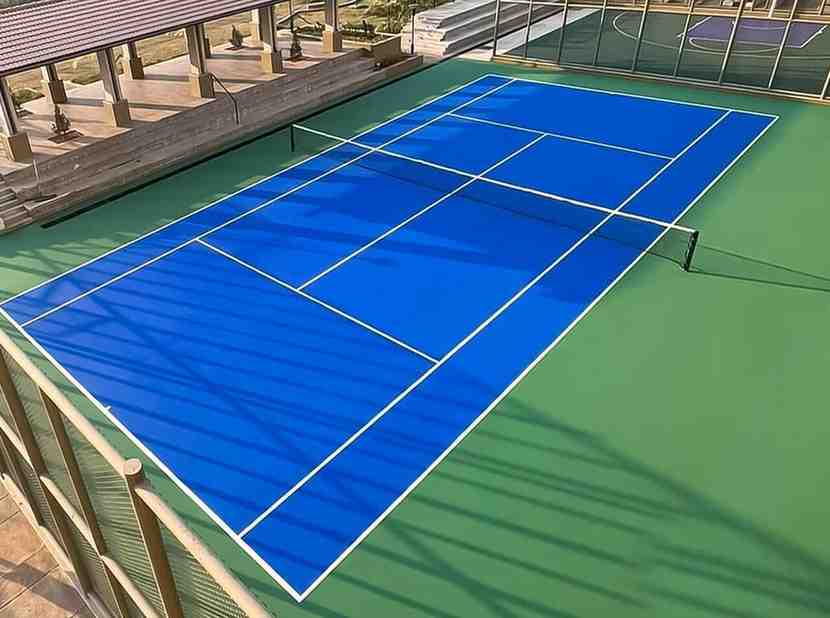
Construction and maintenance activity for tennis courts heavily rely upon the flooring selected. The surface would alter ball bounce, players’ movement, and overall comfort of the game. Knowing the impact of tennis court flooring on maintenance when creating a new court or repairing an existing one is crucial for the overall enjoyment and high-performance level of the playing experience. Within this article, we will uncover the reasons behind the importance of your tennis court flooring and how it influences every single aspect of the game.
Importance of Flooring for the Tennis Court
Ball Bounce & Speed
The type of surface material used heavily influences interactions between a ball and the court. For example, synthetic tennis court cost surfaces usually attract a much more consistent bounce that is favored by precision players. On the other hand, hard courts are constructed predominantly of asphalt or concrete, thereby enabling faster games with less bounce-more conducive to aggressors that rely on speed. In contrast, clay provides more time for rallies by offering slow down-ball speed and high bounce.
The bounce of the balls and the speed of the games are two key concepts that have a direct effect on the performance of the players. Hence, when making a choice for flooring during construction phases, a court’s surface is paramount.
Comfort for Players and Prevention of Injuries
When talking about synthetic courts, cushioned hard court flooring surfaces absorb lots of shock when compared to traditional clay or grass courts. This ability of the floor is paramount for the health of any and all joints of the players. It gives a reduction in force on knees, ankles, and back, which prevents injuries that may tend to occur during fast-paced and high-impact sports like tennis.
In the backyard, in the case of a tennis court, or in community construction, during consideration of the types of flooring, availability of such flooring options that have sufficient cushioning must be taken into account for long-term comfort and well-being.
How It Affects Maintenance and Durability
Repair of Tennis Court Cracks
For much of the life, any tennis court will be subjected to the ravages of weather and wear. Cracks in court surfaces-hard and synthetic alike-remain prime candidates for occurrence. Periodic fixing of tennis court crack repair is vital to providing a playable surface, further deterioration.
On hard-court surfaces, cracks generally develop due to changes in weather temperatures or moisture, poor drainage, or settlements of the ground. In a similar manner to hard surfaces, synthetic courts have their issues, which may include the lifting or wear of the surface finish. Be it resurfacing or spot repairs, a well-maintained court makes a happier playing environment for all.
The price of synthetic tennis courts is an essential consideration in choosing a particular type of surface. While most synthetic options have a more costly installation fee attached to them, their resistance to wear and low maintenance compared to natural surfaces such as grass or clay makes them attractive. Synthetic courts are easy to maintain, and being durable gives rise to fewer repairing jobs. This makes synthetic courts a possible long-term saving when it comes to the cost of tennis court repair.
The Longevity of Materials and Weather Resistance
Tennis court flooring should be resistant to weather elements over time. Natural surfaces, however appealing to the eye, require excessive efforts concerning maintenance to keep playability intact. In contrast, synthetic and hard court surfaces are generally more durable toward climatic elements, meaning much less repair work is needed on the courts. These surfaces will usually hold up against sun, rain, and even snow without compromising their condition when the seasons change.
Right Flooring to the Appropriate Style
Picking the flooring suitable for your style of play considers court measurements in feet, venue, and your desired play style. If you are about to construct a court or are thinking about resurfacing one, all options should be aired out accordingly.
- Hard Courts: A very resilient option and a value-for-money product for those that favor fast-paced games. They represent less maintenance overall but require some periodic crack repairs.
- Synthetic Courts: They provide a contemporary low-maintenance alternative that affords an even playing surface with outside durability. They are relatively more durable and require a more substantial initial investment but significantly alleviate maintenance and repair costs over time.
Conclusion
In tennis, the choice of surface is everything. Be it about repairing tennis court cracks or costs concerning a synthetic tennis court, to upgrading tennis court flooring, each choice you make has an impact on the playing performance of the sport among various others. Therefore, the correct choice of surface plus good maintenance gives a better gaming experience and ensures it lasts longer.